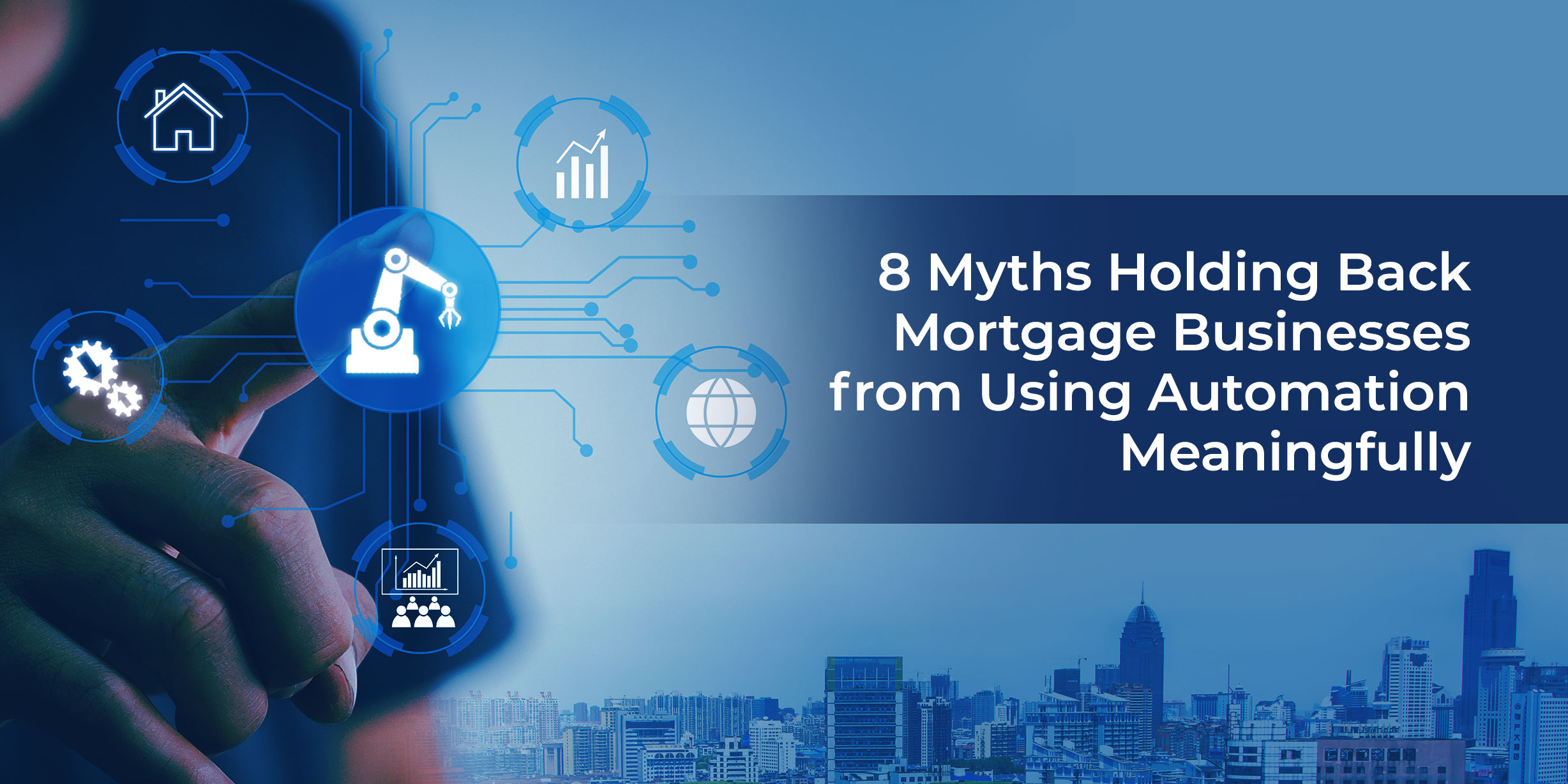The benefits of mortgage automation are now well-established. In a 2021 industry report, 99% of lenders asserted that technology was crucial to improving mortgage processes – making mortgage simpler (74%), minimizing data entry (67%), and reducing time to close (70%). Yet, the true rate of automation adoption remains woefully low. Apart from one or two pilot projects, most lenders do not have fully digital processes and struggle to realize the benefits of strategic mortgage automation. For example, just 1% of mortgage lenders in the US consider their back offices to be fully digital.
Let that number sink in – 1% of industry players have been able to successfully implement and gain from automation, despite the fact that it’s now a relatively mature technology. Its benefits are proven and the risks relatively low, so what’s holding businesses back? In our experience, mortgage providers encounter 8 myths on their transformation journey that hold them back in their tracks. These myths can be easily dismantled, but what’s needed is a culture of openness and the right support.
1. Automation means ripping and replacing existing processes
Businesses often assume that, because automation is a completely new way of doing things, it involves a full rip-and-replace approach. Their existing processes have to be overhauled from scratch, and new processes must be instituted, ensuring automation readiness. In reality, modern automation solutions use application programming interfaces (APIs) and other purpose-built connectors to fetch data, enable workflows, and drive outcomes while co-existing with the current landscape.
2. Mortgage automation involves very high capital expenses
Another common myth that mortgage businesses will face during the research and reconnaissance stage is capital expenditure. Due to the slew of complex automation solutions available in the market, one imagines that initial costs will be formidable. In reality, mortgage automation is now available on an affordable, as-a-Service model, like most technology solutions. You can simply pay a monthly subscription fee and install the solution remotely on the cloud, avoiding high capital costs.
3. Automation is synonymous with AI chatbots, and only the customer gains
While it is true that artificial intelligence (AI) and automation go hand in hand, they are not identical. Specifically, first-time automation users tend to conflate the technology with AI chatbots that streamline front processes like customer communication. In reality, this is just one aspect of the true potential of mortgage automation. You can definitely reduce the need for human servicing agents to answer FAQs, retrieve data, accept applications, etc. – but these will be connected to a digital back-office workflow.
4. The total cost of ownership (TCO) will not justify ongoing costs
When mortgage automation was first introduced, it did involve a high TCO, due to complex scripts that needed constant attention, fragmented and non-standardized systems, and the absence of the cloud. All of these roadblocks have changed in the last five years. Particularly during the pandemic, automation technology and the cloud have evolved in leaps and bounds to make next-gen mortgage solutions easily accessible at low overheads. Indeed, its revenue generation potential is higher than ever before.
5. We do not have the in-house skills to manage and maintain automation
Lenders often cite the lack of in-house technical skills as a reason to put off automation. In reality, modern solutions do not call for any special technical knowledge from users, and employees in any role can gain from its intuitive, consumer-grade graphical user interface (GUI). What’s more, outsourcing gives you the option to share automation ownership with a trusted third party, further reducing the need for in-house efforts.
6. Automation will make our employees redundant
While mortgage automation can shrink headcount in specific functions and departments, its main role is not to replace human employees. It primarily takes over high volume, iterative tasks that are not a good use of employee time and talent in the first place. This leaves your workforce free to focus on more value-adding initiatives that actually require cognitive judgment. For example, armed with an automation tool, a servicing executive can devote an extra five minutes to a difficult customer and not have to spend that time on data entry.
7. You have to be a digital native to embrace mortgage automation
This is another common myth that has emerged in the era of fintech and digital-only businesses. While it is true that this new generation of lenders overwhelmingly uses automation in their back, middle, and front offices, it is only due to the low barriers to entry. Incumbent firms can also embrace automation and leverage it alongside their well-established processes, without any friction. Automation readiness depends on the nature of processes and the current degree of digital maturity – and not whether you started as a digital company.
8. Borrowers still prefer to interact with a human mortgage representative
Financial service providers often believe that customers prefer a “human touch,” which makes automation unnecessary. In reality, borrowers tend to prefer businesses with automation and technology capabilities. In a 2021 survey, 58% of borrowers said that the ability to apply online would influence their choice of lenders, and 49% appreciated that automation resulted in fewer in-person interactions. In other words, mortgage automation provides you with a competitive advantage and is perfectly in sync with consumer behavior. And, you can always keep a human in the loop (HITL) to attend to the knottier scenarios.
In over a decade of working on mortgage automation, we have encountered these (and several other) myths that routinely hold back lenders from digital transformation. That’s why our team of more than 1,000 subject matter experts provide tailored solutions to streamline your automation journey, from the early stages of adoption to maintenance and ongoing upgrades. Remember, mortgage automation is not a set-and-forget initiative, and its maximum value is often revealed with time and with scale.
Are you ready to dismantle the myths holding back your businesses’ automation potential? Speak with our Tech Gurus to know more, today.



